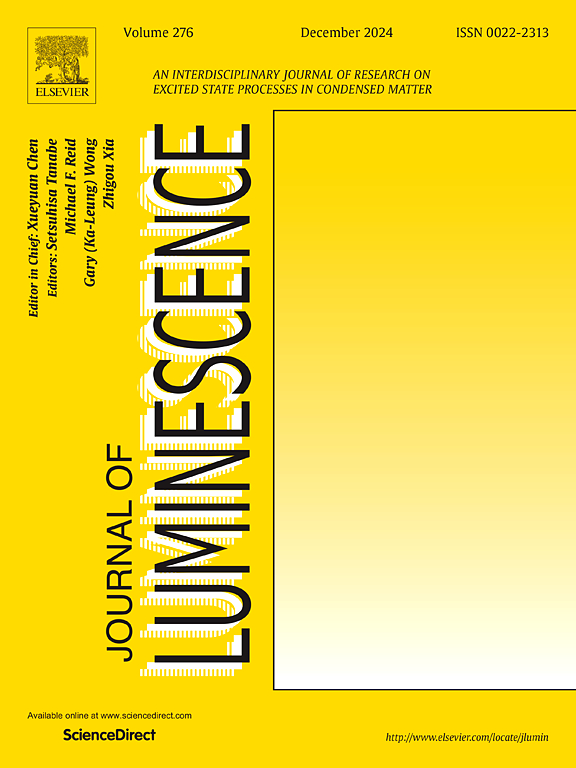Theoretical study on the kinetic control mechanism of ESIPT for the photocyclization of diarylethylethene derivatives
IF 3.3
3区 物理与天体物理
Q2 OPTICS
引用次数: 0
Abstract
Multifunctional photochromic diarylethylethene derivatives have attracted much attention from researchers due to their unique physicochemical properties originated from photocyclization. Yu et al. synthesized a terthiazole-based diarylethenes (ap-P) featuring intramolecular hydrogen bonds in experiment. They supposed that there was a competitive relationship between photocyclization and excited-state intramolecular proton transfer (ESIPT). To gain deeply insight into the connection between two reactions, the geometry optimization, the calculation of electron spectra, and the construction of minimum energy paths of ESIPT and cyclization were carried out under solvent and gas phases. These studied were based on closed shell and unrestricted open shell density functional theory, as well as other quantum chemistry methods. Moreover, qualitative and quantitative analyses of the electron structure revealed that the competition between two reactions is fundamentally driven by changes in aromaticity and electron delocalization. Furthermore, it was theoretically proved that the regulation of ESIPT is realized by changing environmental parameters, leading to a novel method for precise control of photocyclization reaction. It is expected to provide theoretical guidance and prediction for the flexible application of multifunctional photochromic molecular switches in photoelectric materials, biomedicine and other fields.

ESIPT对二芳基乙烯衍生物光环化的动力学控制机理的理论研究
多功能光致变色二元鱼藤烯衍生物因其源自光环化的独特物理化学性质而备受研究人员的关注。Yu 等人在实验中合成了一种以分子内氢键为特征的terthiazole-based diarylethenes (ap-P)。他们认为光环化与激发态分子内质子转移(ESIPT)之间存在竞争关系。为了深入了解这两个反应之间的联系,他们在溶剂和气相条件下进行了几何优化、电子能谱计算,并构建了 ESIPT 和环化的最小能量路径。这些研究基于闭壳和无限制开壳密度泛函理论以及其他量子化学方法。此外,对电子结构的定性和定量分析表明,两个反应之间的竞争从根本上说是由芳香性和电子脱ocalization 的变化所驱动的。此外,还从理论上证明了通过改变环境参数可以实现对 ESIPT 的调控,从而为精确控制光环化反应提供了一种新方法。它有望为多功能光致变色分子开关在光电材料、生物医学等领域的灵活应用提供理论指导和预测。
本文章由计算机程序翻译,如有差异,请以英文原文为准。
求助全文
约1分钟内获得全文
求助全文
来源期刊

Journal of Luminescence
物理-光学
CiteScore
6.70
自引率
13.90%
发文量
850
审稿时长
3.8 months
期刊介绍:
The purpose of the Journal of Luminescence is to provide a means of communication between scientists in different disciplines who share a common interest in the electronic excited states of molecular, ionic and covalent systems, whether crystalline, amorphous, or liquid.
We invite original papers and reviews on such subjects as: exciton and polariton dynamics, dynamics of localized excited states, energy and charge transport in ordered and disordered systems, radiative and non-radiative recombination, relaxation processes, vibronic interactions in electronic excited states, photochemistry in condensed systems, excited state resonance, double resonance, spin dynamics, selective excitation spectroscopy, hole burning, coherent processes in excited states, (e.g. coherent optical transients, photon echoes, transient gratings), multiphoton processes, optical bistability, photochromism, and new techniques for the study of excited states. This list is not intended to be exhaustive. Papers in the traditional areas of optical spectroscopy (absorption, MCD, luminescence, Raman scattering) are welcome. Papers on applications (phosphors, scintillators, electro- and cathodo-luminescence, radiography, bioimaging, solar energy, energy conversion, etc.) are also welcome if they present results of scientific, rather than only technological interest. However, papers containing purely theoretical results, not related to phenomena in the excited states, as well as papers using luminescence spectroscopy to perform routine analytical chemistry or biochemistry procedures, are outside the scope of the journal. Some exceptions will be possible at the discretion of the editors.
 求助内容:
求助内容: 应助结果提醒方式:
应助结果提醒方式:


